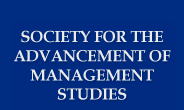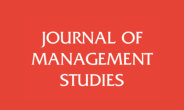Guest Editors:
Shahzad (Shaz) Ansari, University of Cambridge, UK
Raghu Garud, Pennsylvania State University, USA
Arun Kumaraswamy, West Chester University of Pennsylvania, USA.
Submission Deadline:
15th December 2016
Background to the Special Issue
It is hard to deny that we are living in an age of disruption, defined vernacularly as fundamental changes that disturb or re-order the ways in which organizations and ecosystems operate. Researchers studying technological innovation in the 1980s focused on (among other issues) transilience (Abernathy and Clark, 1985), which culminated in the emergence of dominant designs (Tushman and Anderson, 1986; Utterback and Abernathy, 1975). The 1990s saw the advent of disruptive technologies, a concept that Christensen (1997) introduced to talk about how incumbents are disrupted and then lose ground against new entrants. The 21st century has seen the advent of continual disruption, as incessant technological advances and changes lead to disruption of not just individual firms but entire industries and ecosystems through a process of cumulative synthesis (Usher, 1954).Disruption is not a one shot deal or “a carefully planned forward march”, but rather a process (Christensen, 2006; Christensen and Raynor 2003), posing dilemmas for both incumbents and new entrants (Ansari, Garud and Kumaraswamy, 2015). Incumbents may want to ride the wave of creative destruction, and yet are reluctant to relinquish the basis for their existing competitive advantage (e.g., Christensen, 2006; Kapoor and Klueter, 2014). New entrants also confront the dilemma of gaining support of the very incumbent firms that stand to be “disrupted” by entrants’ innovations (Ansari et al., 2015; Faems et al., 2012).
An exploration of these issues implicates theoretical perspectives and topics from various disciplines such as (a) ecosystems and platform dynamics from technology studies; (b) transformation of business models and pivoting from entrepreneurship; (c) co-opetitive dynamics and dynamic capabilities from economics and strategic management; (d) framing strategies from institutional theory; and (e) ambidextrous organizations for simultaneous exploration and exploitation from management of technology/innovation. As even this short indicative list demonstrates, studying this phenomenon is a multi-disciplinary endeavour spanning multiple levels of analysis (intra-firm, inter-firm, industries/ecosystems/organizational fields, and institutional).
Recent debates on what constitutes disruptive innovation and the methods appropriate for its study (e.g., Christensen, 2006; Christensen, Raynor and McDonald, 2015; King and Baatartogtokh, 2015; Lepore, 2014; Markides, 2006) demonstrate a need for cumulative theorizing that can better inform academia and practice. Consequently, a key objective of this Special Issue is to take stock of extant research and emerging practice on this topic. We encourage submission of papers (both conceptual/theory development and empirical) from multiple disciplines that seek to answer questions such as:
- How might we conceptualize disruption as a process, and what are the temporal dynamics?
- How might disruptors frame their disruptive innovations (internally and to ecosystem members), and how does such framing change over time?
- How do incumbents react to disruptive innovations? How can they depart from their own products and services to offer disruptive innovations?
- How do disruptors deal with inertia and resistance?
- How might a disruptor’s efforts to address emergent tensions affect its legitimacy and its relational positioning within an ecosystem over time?
- How may the balance between cooperation and competition among firms shift over time as a disruption unfolds?
- What is the impact of a disruptive innovation on related/adjacent industries?
- What forms of organizing are required for navigating disruptive innovations?
- How do disruptors deal with and shape institutional environments?
Given the multi-disciplinary and multi-level nature of the Special Issue topic, we encourage empirical studies using a variety of methods (qualitative and quantitative). Authors, however, are advised to refer to the JMS Author Guidelines (see: http://www.socadms.org.uk/journal-management-studies/submission-guidelines/types-of-jms-articles/ ) to ascertain the specific types of articles that JMS seeks to publish.
Submission Process and Deadlines
- Manuscripts will be reviewed according to the JMS double-blind review process.
- Submissions should be prepared using the JMS Manuscript Preparation Guidelines (see: http://www.socadms.org.uk/wp-content/uploads/JMS-Manuscript-Preparation-Guidelines.pdf)
- The deadline for submission is 15th December, 2016.
- Manuscripts should be submitted by e-mail to the guest editors at: jmsdisruptions@gmail.com
- For informal inquires related to the Special Issue, proposed topics and potential fit with the Special Issue objectives, please contact the guest editors at the above e-mail address.
Articles cited
Abernathy, W. J. and Clark, K. B. (1985). ‘Innovation: Mapping the winds of creative destruction’. Research policy, 14, 3-22.Ansari, S. A., Garud, R. and Kumaraswamy, A. (2015). ‘The Disruptor’s Dilemma: TiVo and the U.S. Television Ecosystem’. Strategic Management Journal. (doi/10.1002/smj.2442/abstract)
Christensen, C. (1997). The Innovator’s Dilemma: When New Technologies Cause Great Firms to Fail. Cambridge, MA: Harvard Business School Press.
Christensen, C. (2006). ‘The ongoing process of building a theory of disruption’. Journal of Product Innovation Management, 23, 39–55.
Christensen, C., Raynor, M. and McDonald, R. (2015). ‘What is disruptive innovation?’. Harvard Business Review, December, 44-53.
Faems, D., Janssens, M., Van Looy, B. and Vlaar, P. (2012). ‘Value creation in asymmetric new venture development alliances’. Journal of Engineering and Technology Management, 29, 508-27.
Kapoor, R. and Klueter, T. (2015). ‘Decoding the adaptability-rigidity puzzle: Evidence from pharmaceutical incumbents’ pursuit of gene therapy and monoclonal antibodies’. Academy of Management Journal, 58, 1180-207.
King, A. and Baatartogtokh, B. (2015). ‘How useful is the theory of disruptive innovation’. MIT Sloan Management Review, 57, 77-90.
Lepore, J. (2014). ‘The disruption machine: What the gospel of innovation gets wrong’. The New Yorker, May 23.
Markides, C. (2006). ‘Disruptive innovation: In need of better theory’. Journal of Product Innovation Management, 23, 19-25.
Tushman, M. L. and Anderson, P. (1986). ‘Technological discontinuities and organizational environments’. Administrative Science Quarterly, 31, 439-465.
Usher, A. P. (1954). A History of Mechanical Inventions. Cambridge, MA: Harvard University Press.
Utterback, J. and Abernathy, W. (1975). ‘A dynamic model of process and product innovation’. Omega, 33, 639-56.
The Call can be downloaded here: JMS Special Issue – Managing in the Age of Disruption – Call for Papers

